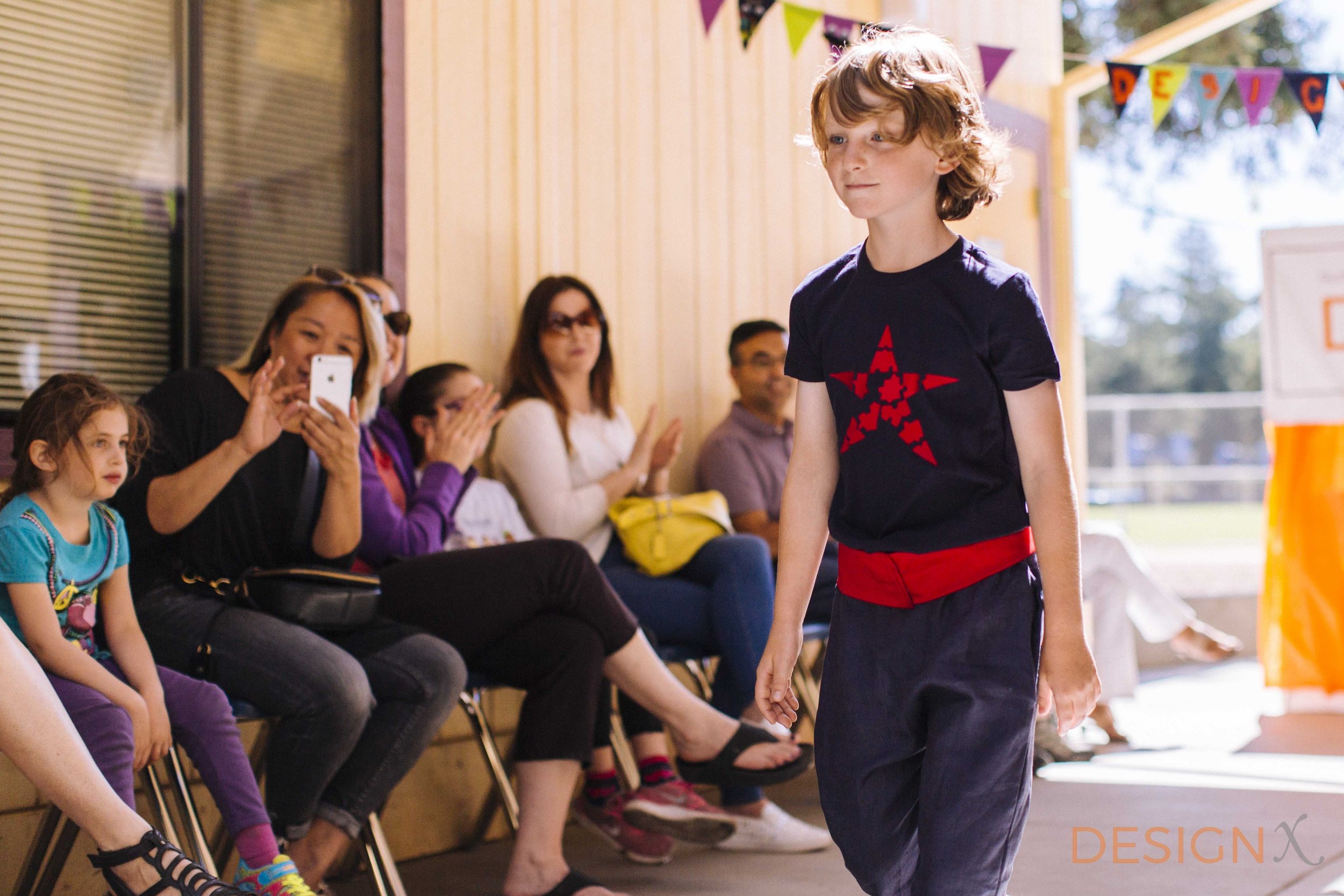Why celebrate EARTH day?
By Margie Suozzo, Community Leader and Board Member, GreenTown Los Altos and Team DesignX
Imagine this. If all people on our precious planet consumed food, clothing, and goods at a rate that Americans consume, we would need more than 5.1 Earths to sustain us. The problem is, we have only one. The products we consume impact people and the planet throughout their lifecycle: from extraction, production, and distribution, to consumption and disposal. Businesses are producing products to maximize profits. Consumers are purchasing to minimize costs. But the costs to the environment and our future are often not included on either side of the equation. Our over consumption habit is filling up landfills and polluting our air, soil and water. Enter visions of “Wally”, after the humans had escaped the ravaged earth, piling garbage evermore.
One of our student designer/maker proudly showing off his upcycled T-shirt.
So what is the solution?
Buy Less! Live More!
Consumers can buy less and reuse and share more.
Buy less. For most things, you probably don’t need it. When you do buy:
Look for products that use circular economy principles on the Cradle to Cradle Certified Registry
Choose durable, quality goods that have a lifetime guarantee or that you know will last a long time
Reuse/share
Purchase goods second hand from local and online re-sellers, like Thred-Up and PoshMark.
Organize a clothing swap with friends. Local blogger, Kanesha Baynard (boldlivingtoday.com), and friends run an annual Sip and Swap where one woman’s trash is another’s treasure.
Encourage “repair cafes” in your community - where amateur tinkerers can help extend the life of household appliances, consumer electronics and other products in disrepair. Repair cafes started in the Netherlands but have made their mark in Palo Alto, Mountain View and Sunnyvale.
Participate in the sharing economy. Nextdoor.com and other resources can help make sharing easier for you. Neighbors, more often than not, are willing to lend baby gear, tools, or other “stuff” on a short-term basis.
Responsible Business!
Many businesses operate on a planned obsolescence model, designing and building products that they know will be obsolete in 3-6 months. Or they produce fast fashion that they know will not be desirable in short order, ensuring that customers will keep coming back for more. But there are excellent examples of companies taking the lead on sustainability through “cradle to cradle” or “circular economy” design, in which manufacturers design products for durability and reuse.
Patagonia: Patagonia focuses on creating quality, durable products that can be repaired and recycled. It backs up this effort with a lifetime guarantee. To “close the loop,” the company created a fleece made from recycled plastic bottles and shared the technology with other manufacturers.
LooptWorks: Looptworks creates products from pre-consumer excess fabric as well as from goods that would otherwise be thrown away. They partner with a range of companies, to secure materials and create ”meaningful, long-lasting and limited edition products.” For example, LooptWorks worked with Southwest Airlines and subsequently Alaska Airlines to repurpose old seat fabric into products such as high-end handbags, duffles and soccer balls.
Thred-Up and PoshMark: Thred-Up and PoshMark don’t produce products but rather provide a platform for users to buy and sell gently-used apparel and accessories online. Products are offered a second life at deep discounts off of retail!
Upcycling - The images above showcases fun hair accessories designed and made by our budding fashionistas
REcycling, DOWNcycling, UPcycling!
The triangular recycling symbol is intended to remind us that recycling closes the loop. Materials created with energy and other inputs, once recycled, are put back into the economy as another product. In the ideal world, all products could be recycled into the same products - a plastic bottle becomes a plastic bottle or office paper becomes office paper. But typically the material degrades on recycling, known as downcycling, as a result of contamination or processing. Plastic bottles may become furniture, office paper becomes lower grade paper, and so on.
In contrast, upcycling reuses or re-purposes items, making them better than the originals. In fashion, this often means taking something that doesn’t fit or is stained and refashioning it into another product. Upcycling reuses textiles, that would most likely end up in the trash, in a creative way.
Creative ReCycling!
DesignX is proud to use post-consumer waste like fabric scraps from various projects, either donated by the community or left over from student projects, for design challenges and small projects. The team also regularly scours through tons of fabric samples donated by design houses to FabMo, a local non-profit dedicated to fabric and textile recycling. FabMo provides unique, high-end materials so that individuals can rescue and reuse them for creative purposes. The company makes all of their materials available on a donation basis and diverts about 70 tons per year from entering into the landfill. DesignX students repurpose these designer fabrics converting them to iphone cases, pillow cases, wallets and more.
Upcycling made fun!
Respecting our resources of all kinds is core to our belief and this summer DesignX is proud to offer a program dedicated entirely to sharing the concepts of upcycling with our youngest of students - ages 7y-9y. In this program, kids will learn to re-purpose knitted T-shirts and Jeans ... the fabrics we see highly consumed and wasted. Students will learn to upcycle T-shirts converting them to stylish handles, headbands and other finished products. They will learn to upcycle denims converting them to fashionable accessories.
Kids are naturally curious and perceptive and what a great opportunity to drive the value system for the next generation, leaving our planet in good hands. We look forward to developing our students appreciation for their resources as they give new life to things that otherwise are destined for the landfill.
The images above showcases creative reuse of fabric scraps by DesignX students.





